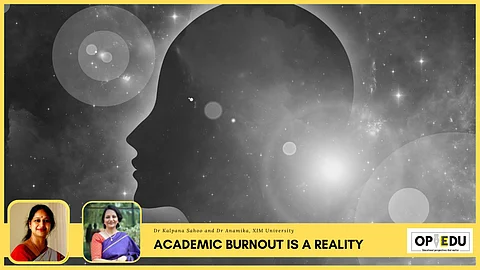

Brands today are promoting and co-creating a space for themselves by engaging with consumers and customers on social media platforms by finding out their feedback and comments.
Consumer/customer co-creation effort positively impacts customer satisfaction, behavioural intentions, customer well-being, and quality of association.
Jeff Bezos, Founder of Amazon, has famously said, “Your brand is what people say about you when you’re not in the room.”
Personal branding is gaining grounds with the advent of social media and is no longer limited to brands alone. A personal brand is the unique combination of abilities, human qualities and cognitive content that transforms a person into a brand. It is how a person presents himself to the world.
In the context of education
Approaching high school education with similar postulates, it is important to question if educationists value the art of co-creation to improve student satisfaction in developing their own brand and image, the right kind of behavioural intentions, student well-being and quality of association.
Burnout was a term generally associated with working professionals, however, now it has trickled down and is widely used for students who are facing high academic stress. High school students are spending long hours to complete academic tasks and are under exam-related stress due to the exam-oriented system.
This pressure and stress increases manifold if the child is preparing for competitive exams such as Joint Entrance Exams (JEE) or National Eligibility-cum-Entrance Test (NEET).
The flooding parental expectations, high standards of academic performance set by the school and peer pressure are leading to academic burnout.
Researchers have defined academic burnout as exhaustion (feelings caused by academic demands), cynicism (a cynical and uninvolved attitude to academic tasks) and reduced professional efficacy (incompetent feelings) observed among students.
Another crucial factor associated with academic burnout is the estranged relationship between teachers and students.
Teachers are under pressure to complete the syllabus and give advanced content to the students to meet the new requirements of education reformation, resulting in alienated and disoriented students who fail to handle pressure. The outcome of this academic burnout leads to mental health problems, lack of concentration, restlessness, lack of remorse, argumentativeness, hyperactive behaviour, poor marks and even suicidal tendencies.
As these students join universities and Higher Educational Institutes (HEIs), they are more prone to develop anxiety, mood swings, high or severe psychological distress and low psychological well-being. These conditions among students have an adverse impact on their participation, engagement, and performance. If left untreated, they can also have unfavourable long-term outcomes related to employment opportunities, income generation and social relationships.
Therefore, it is of crucial importance to examine the prevention interventions and potential mechanisms to help academic institutions deal with the academic burnout and mental health of students.
How can we keep a check on this?
To check this growing threat of academic burnout of brilliant young minds it is important that emphasis is given to students’ co-creation effort and student-to-teacher and student-to-student interactions.
The first intervention is the teacher-student co-creation process. When students face academic stress or have difficulties in studying, teachers' support is more instrumental than that of parents as teachers’ support gives assurance and intrinsic motivation.
Teachers are the frontline representatives because of their direct engagement with students and their interaction quality is likely to enrich students’ experience and make them feel valued in the learning process. Support can be offered in the form of regular mentor-mentee programmes, wherein, every teacher is allocated a few students. Then, the teacher mentors the student to attain career objectives and also counsels the student on emotional stability and general well-being.
Student opinion/expectations should be given value in organising programmes and competitions to sharpen their decision-making, leadership, team-building and interpersonal skills, which can help develop social interactions and overall, life satisfaction.
In addition, the second intervention can be mindfulness workshops for the students.
Mindfulness is a cognitive state of being attentive to and aware of what is currently taking place. It serves to increase and sustain attention and develop mechanisms for coping with pressure and burnout.
Researchers, from time to time, have advocated for mindfulness to facilitate students’ mindful consumption behaviours, life satisfaction, psychological well-being, adjustment to feelings of inadequacy, performance concerns, and motivation shortage through its correlation with cognitive reappraisal and resilience in college students.
Additionally, it is of utmost importance to educate students to seek professional help if they feel disturbed, dejected and they are unable to cope with their daily routine due to psychological issues and not to feel embarrassed about it.
Third, an important intervention which is likely to help in developing student well-being is student-to-student interactions. Schools, with the help of technology, can initiate platforms for like-minded students as per their interest to discuss and talk over issues which trouble them.
These kinds of platforms are sure to encourage them to share issues which go unnoticed but might be stressing out the student community.
What institutions can do?
Institutions can also promote community development projects to promote empathy among students and social responsibility at large.
These steps are sure to help in Social Emotional Learning (SEL), which refers to developing skills and aptitude to build a healthy social and emotional environment. Engaging in local civic projects offers students meaningful learning opportunities, fosters co-creation and supports the community at large.
These experiences of mindfulness and co-creation with teachers and their peer groups are sure to generate memorable experiences, reduce stress and burnout and help in developing a healthy mindset and an efficient academic system.
These new ways of working and engagement lead to new partnerships, improved processes and outputs, and offer exciting opportunities to improve learning and practice for students.
(Dr Anamika, School of Communications and Dr Kalpana Sahoo, School of Human Resource Management from XIM University are the authors of this piece. Views expressed are their own)
